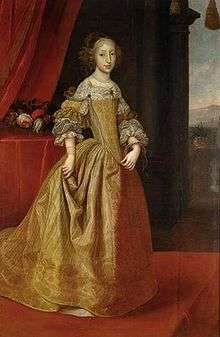|
|---|
|
| 1st generation | |
|---|
|
| 2nd generation | |
|---|
|
| 3rd generation | |
|---|
|
| 4th generation | |
|---|
|
| 5th generation | |
|---|
|
| 6th generation |
- Isabella Clara Eugenia, Co-sovereign of the Habsburg Hetherlands*
- Catherine Michelle, Duchess of Savoy*
- Archduchess Maria*
- Anna, Queen of Spain
- Elisabeth, Queen of France
- Archduchess Maria (1555–56)
- Archduchess Maria (1564)
- Archduchess Margaret (1567–1633)
- Archduchess Eleanor (1568-80)
- Archduchess Maria (1562-67)
- Archduchess Anna Eleanor
- Archduchess Maria (1584–1649)
- Anna, Holy Roman Empress
- Anna, Queen of Poland
- Maria Christina, Princess of Transilvania
- Archduchess Catherine Renata
- Archduchess Elisabeth (1577–86)
- Archduchess Gregoria Maximiliana
- Archduchess Eleanor (1582–1620)
- Margaret, Queen of Spain
- Constance, Queen of Poland
- Maria Maddalena, Grand Duchess of Tuscany
|
|---|
|
| 7th generation | |
|---|
|
| 8th generation | |
|---|
|
| 9th generation | |
|---|
|
| 10th generation | |
|---|
|
| 11th generation | |
|---|
|
| 12th generation | |
|---|
|
| 13th generation |
- Archduchess Ludovika Elisabeth
- Marie Louise, Empress of the French
- Archduchess Carolina Ferdinande**
- Archduchess Maria Caroline
- Archduchess Caroline Ludovika
- Maria Leopoldina, Empress of Brazil
- Clementina, Princess of Salerno
- Archduchess Maria Luisa**
- Archduchess Alexandrine
- Maria Theresa, Queen of Sardinia**
- Marie Caroline, Crown Princess of Saxony
- Archduchess Maria Anna
- Archduchess Amalia Theresa
- Maria Theresa, Queen of the Two Sicilies
- Maria Theresa, Countess of Chambord***
- Archduchess Hermine
- Archduchess Franziska
- Archduchess Maria Caroline
- Adelaide, Queen of Sardinia
- Maria Beatrix, Countess of Montizón***
- Archduchess Maria Caroline
- Archduchess Elisabeth Franziska
- Marie Henriette, Queen of the Belgians
|
|---|
|
| 14th generation | |
|---|
|
| 15th generation |
- Archduchess Sophie
- Gisela, Princess Leopold of Bavaria
- Archduchess Marie Valerie
- Margarete Sophie, Duchess of Württemberg
- Archduchess Maria Annunziata
- Elisabeth, Princess Aloys of Liechtenstein
- Archduchess Maria Antonietta**
- Luise, Crown Princess of Saxony**
- Anna, Princess of Hohenlohe-Bartenstein**
- Archduchess Margareta**
- Archduchess Germana**
- Archduchess Agnes**
- Archduchess Maria Theresa**
- Karoline Marie, Princess Leopold of Saxe-Coburg and Gotha**
- Archduchess Maria Antonietta**
- Maria Immaculata, Duchess of Württemberg**
- Archduchess Henriette**
- Maria Christina, Princess Emmanuel of Salm-Salm
- Maria Anna, Princess Elias of Bourbon Parma
- Maria Henrietta, Princess of Hohenlohe-Waldenburg-Schillingsfürst
- Archduchess Natalie
- Archduchess Stephanie
- Archduchess Gabrielle
- Isabella, Princess Georg of Bavaria
- Alice, Baroness Waldbott of Bassenheim
- Archduchess Eleonora, Mrs. Alfons von Kloss
- Renata, Princess Hieronymus Radziwill
- Mechthildis, Princess Olgierd Czartoryski
- Archduchess Gisele
- Archduchess Sophie
- Archduchess Magdalena
|
|---|
|
| 16th generation |
- Elisabeth Marie, Princess of Windisch-Graetz
- Helena, Duchess Philipp of Württemberg**
- Rosa, Duchess of Württemberg**
- Archduchess Dolores**
- Maria Inmaculada, Nobile Inigo Neri Sereneri**
- Margarita, Marchioness Taliani di Marchio**
- Princess Maria Antonia, Mrs. Luis Pérez**
- Archduchess Assunta, Mrs. Joseph Hopfinger**
- Elisabeth, Countess of Waldburg-Zeil**
- Hedwig, Countess of Stolberg-Stolberg**
- Gertrud, Countess of Waldburg-Zeil-Trauchburg**
- Archduchess Maria Elisabeth**
- Archduchess Agnes**
- Archduchess Margarethe, Mrs. Alexander Cech
- Ilona, Duchess of Mecklenburg
- Archduchess Anna Theresia
- Archduchess Maria Kynga, Mrs. Joachim Krist
|
|---|
|
| 17th generation |
- Descent of Charles I :
- Archduchess Adelheid
- Charlotte, Duchess of Mecklenburg
- Elisabeth, Princess Heinrich of Liechtenstein
Tuscany :
- Elisabeth, Edle Hubert von Braun**
- Alice, Baroness Vittorio Manno**
- Marie Antoinette, Baroness of Proff in Irnich**
- Archduchess Marie Christine**
- Archduchess Walburga, Mrs. Carlos Tasso**
- Archduchess Verena**
- Archduchess Katharina, Mrs. Roland Huber**
- Agnes, Baroness Peter of Fürstenberg**
- Maria Ileana, Countess Adam Kottulinski**
- Alexandra, Baroness Viktor of Baillou**
- Maria Magdalena, Baroness of Holzhausen**
- Archduchess Elisabeth, Mrs. Friedrich Sandhofer**
- Agnes, Princess Karl Alfred of Liechtenstein**
- Archduchess Maria Margaretha**
- Archduchess Ludovica**
- Archduchess Allix**
- Josepha, Countess Clemens of Waldstein-Wartenberg**
- Valerie, Margravine of Baden**
- Alberta, Baroness Alexander of Kottwitz-Erdödy**
- Theresa, Princess Rasso of Bavaria**
- Maria Inmakulata, Countess Reinhart of Hoensbroech**
Palatines :
- Archduchess Monika, Mrs. Charles de Rambures
- Archduchess Marie Christine, Mrs. Raymond van der Meide
- Archduchess Maria, Mrs. Wilhelm de Witt
- Margherita, Countess Benedikt of Piatti
|
|---|
|
| 18th generation |
- Descent of Charles I :
- Andrea, Hereditary Countess of Neipperg
- Monika, Duchess of Maqueda
- Michaela, Countess Hubertus of Kageneck
- Archduchess Gabriela, Mrs. Christian Meister
- Walburga, Countess Archibald Douglas
- Maria Beatrix, Countess Riprand of Arco-Zinneberg***
- Isabella, Countess Andrea Czarnocki-Lucheschi***
- Maria del Pilar, Edle Vollrad-Joachim von Poschinger
- Kinga, Baroness Wolfgang of Erffa
- Archduchess Marie Adelheid, Mrs. Jaime Corcuerra
- Archduchess Viridis, Mrs. Karl Dunning-Gribble
- Archduchess Alexandra, Mrs. Héctor Riesle
- Maria Constanza, Princess of Auersperg-Trautson
- Maria Anna, Princess Peter Galitzine
- Catharina, Countess Maximiliano Secco d'Aragona
Descent of Maximilian :
- Archduchess Elisabeth, Mrs. James Litchfield
- Sophie, Princess of Windisch-Grätz
- Archduchess Marie Christine, Mrs. Clemens Guggenberg
Tuscany :
- Archduchess Marie Bernadette, Mrs. Rupert Wolff**
- Archduchess Katharina, Mrs. Niall Brooks**
- Archduchess Alicia**
- Archduchess Maria Christina**
- Archduchess Margaretha, Mrs. Andreas Baumgartner**
- Archduchess Marie Valerie, Mrs. Martin Josef Wagner**
- Archduchess Hedwig**
- Archduchess Veronika**
Palatines :
- Archduchess Johanna
- Archduchess Elisabeth
- Archduchess Celina
- Archduchess Maria Floriana
- Archduchess Sofía
- Archduchess Anna Carolina
- Archduchess Theresa
- Archduchess Sophie
- Archduchess Ladislaya
|
|---|
|
| 19th generation | |
|---|
|
| 20th generation | |
|---|
|
- * also an infanta of Spain
- ** also a princess of Tuscany
- *** also a princess of Modena
- ° also a princess of Belgium
|
